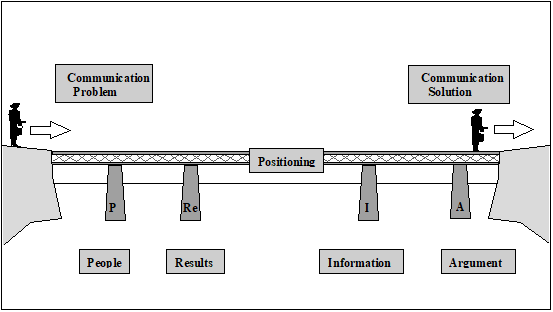
Positioning
Easy reading is hard writing.
– Nathaniel Hawthorne
Introduction
This stage introduces the concept of Positioning, which underlies the writer’s preparation for writing. Through positioning, the writer orientates the document to meet the needs and concerns of the intended reader.
The PRePIA model provides a structured way of approaching positioning by asking questions about:
- the people you want to reach
- the results you want to achieve
- the information you need to convey
- the arguments you need to use
Appropriate positioning is essential if your document is to be persuasive.
The PRePIA model
PRePIA is a short and memorable acronym summarising the factors that lead to writing effective reports and proposals.
PRePIA stands for:
- People
- Results
- Positioning
- Information
- Argument
PRePIA is a foundation for a persuasive document, which will lead you from a communication problem to a communication solution.

When planning and writing any document you must have a clear idea of the People you are writing for and the Results you want to achieve. If you know these, you will be able to Position yourdocument effectively, by making decisions about effective Information and Argument structures. Positioning is the keystone that holds the process together and leads you from your Communication Problem in the direction of a Communication Solution.
Brief check
A position statement is similar to a thesis or objective. It describes one side of a debatable perspective. To compose a position statement, compile a set of arguments supporting a specific viewpoint. Write a phrase or two that summarises the facts and clarifies your position for the audience.
In the PRePIA model, positioning is the structure that holds the bridge together.
What is positioning?
Positioning is the global process of defining a strategy for getting the results you need. On the basis of a positioning strategy, you can make specific, tactical decisions on what information to include, the kind of argument that will work best, and on the details of the style used in communicating your main message.
Positioning is the strategic awareness of the message and audience. Effective positioning requires:
- identifying the People you are writing to;
- knowing what Results you want to achieve;
- defining a single clear Message for those readers;
- understanding what Information your readers need;
- knowing what Argument will best persuade your readers.
How do we position a document?
One basic principle will lead to good positioning: Get into the minds of your readers
To do this, you have to ask yourself the right questions.
| PEOPLE | Who are our readers?
What are their expectations? What are their main concerns? |
| RESULTS | What’s the problem?
What solution are we proposing? What’s the main message? What outcome do we want from the readers? |
| INFORMATION | What essential information must go in the document?
What additional information should go in Annexes? |
| ARGUMENT | What are the main issues we need to discuss?
What are the main points we want to make about each of these issues? |
Brief check
A position statement is like a thesis or goal. It describes one side of an arguable viewpoint.
Primary and secondary readers
If you try to write with no reader in mind, your document will appear diffuse and your message unfocussed.
Primary readers
Your primary reader is the person or persons who will take action on the basis of your paper. This is the reader you should be principally writing for.
Secondary readers
Many documents, however, move through a number of hands before they reach the committee members who act on them. They may have to be agreed by Section Heads, Department Managers or Directors before they reach the hands of the actual decision-maker(s). These intermediaries are your secondary readers.
These readers perform an important document screening function, i.e., theirs is gatekeeping and quality assurance role. Writers must always keep the attitudes, beliefs, agendas and needs of these readers in mind as well.
Your secondary readers are, in fact, collaborative writers. They are stakeholders in the writing process and have personal and professional interests in making sure a well-written document is produced. You should consider your secondary readers, as you would consider colleagues in any other team enterprise. But do not let your desire to satisfy them deflect you from focusing on the primary readers’ needs and expectations.
Brief check
Like a debate, a position paper presents one side of an arguable opinion about an issue. The goal of a position paper is to convince the audience that your opinion is valid and defensible.
Questions to ask yourself
- What’s the corporate problem?
- Who are my primary and secondary readers?
- What results am I trying to achieve?
- What is the main message I want to get across?
- What information will my readers need?
- What arguments will be most persuasive?
Keys to success
IDENTIFY THE CORPORATE PROBLEM
GET INTO THE MINDS OF YOUR READERS
SPECIFY THE RESULTS YOU WANT TO ACHIEVE
DEFINE YOUR SINGLE KEY MESSAGE
INCLUDE INFORMATION ACCORDING TO READERS’ NEEDS
PLAN YOUR ARGUMENT
Dangers to avoid
WRITING WITH NO READER IN MIND
WRITING FOR NO CLEAR REASON
MULTIPLE OR UNFOCUSSED MESSAGES
IRRELEVANT OR UNNECESSARY INFORMATION
UNPLANNED ARGUMENTS





